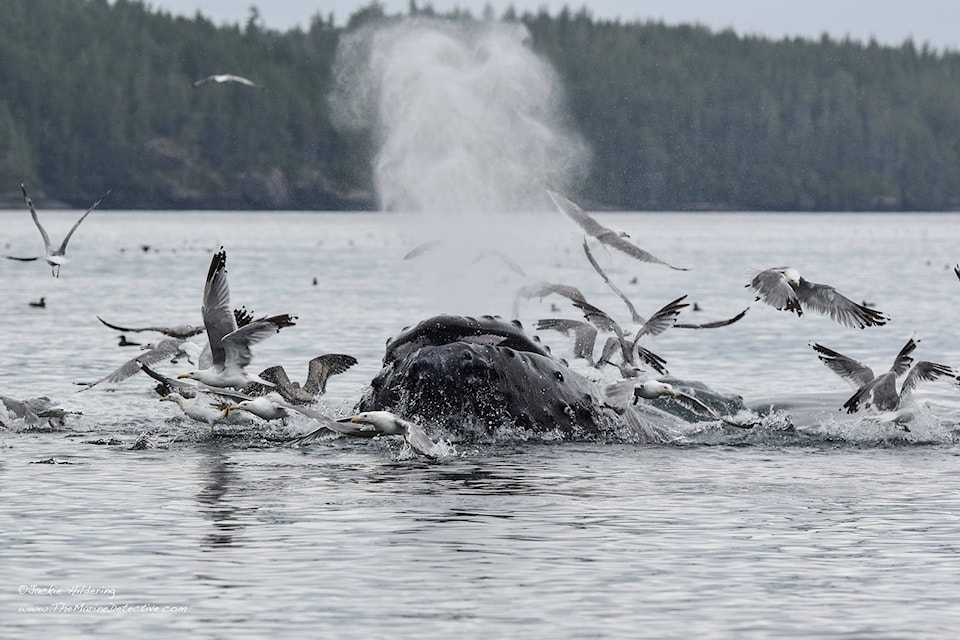A whale researcher will ask British Columbians to be good neighbours to marine giants in an upcoming webinar presented by Nanaimo Area Land Trust.
Jackie Hildering, humpback whale researcher in Port McNeill, will explain how humans can help protect humpback whales in the Return of Giants, a webinar about getting a second chance with the whales that she says came close to extinction before numbers rebounded.
Hildering said data is poor on how many whales there were when whaling was halted in Canada in 1966, but ŌĆ£sightings were the exceptionŌĆØ along the B.C. coast up into the 2000s when their numbers rose from an estimated seven humpbacks sighted in 2003 to 96 counted in the waters of northeast Vancouver Island in 2019.
ŌĆ£It truly is a second chance and itŌĆÖs not just population growth post-whaling. TheyŌĆÖre also shifting from somewhereŌĆ”ŌĆØ said Hildering, who is director of education and communications for the Marine Education and Research Society. ŌĆ£We donŌĆÖt know where that shift is from and what that means in terms of climate and/or prey, so this is a unique chance to learn so much.ŌĆØ
She said thereŌĆÖs knowledge to be gained about climate, ecosystems, social associations and feeding strategies from the whales, which can rest just below the waterŌĆÖs surface or surface unexpectedly after very long dives.
ŌĆ£What has also become so incredibly necessary is boater education,ŌĆØ Hildering said. ŌĆ£[Humpbacks] are a game changer for all flavours of boaters on our coast because theyŌĆÖre giants. The mature females are as big as big as school buses.ŌĆØ
Humpback habits, physical size and even how they sense their environment is different from orcas and dolphins that hunt with their natural form of echo-locating sonar that allows them to track and pinpoint prey and other objects, such as boats.
ŌĆ£[Humpbacks] donŌĆÖt have the bio-sonar of toothed whales,ŌĆØ Hildering said. ŌĆ£Especially when theyŌĆÖre feeding, having left our rich waters to go to the breeding lagoons of primarily Mexico and Hawaii, they are hungry. They are feeding and they are most often oblivious to boats, so thatŌĆÖs one huge educational need to bring across to people.ŌĆØ
ItŌĆÖs also difficult to portray how high the risks of net entanglement and collisions are, she said, because most whales sink when they die. With no dead whale bodies floating on the waterŌĆÖs surface thereŌĆÖs no evidence of a death, but 50 per cent of the whales studied show scars of boat collisions and net entanglement.
ŌĆ£There wasnŌĆÖt even the legal obligation to report collision or entanglement up to ŌĆ” 2018 and even Transport Canada hasnŌĆÖt caught up,ŌĆØ Hildering said. ŌĆ£It will change, but how is even the best-intentioned boater supposed to know about whale behaviour, let alone what the marine mammal regulations are?ŌĆØ
READ ALSO:
Hildering is often asked why humpback whales are here, but the better question, she said, is why would humpbacks leave an area where theyŌĆÖre finding food. The whales belong here because the waters around Vancouver Island are rich in the ŌĆ£planktonic soupŌĆØ they thrive on, the researcher said.
ŌĆ£ThereŌĆÖs this thinking that theyŌĆÖre in transit, but what our research supports is these are neighbours that come back to specific spots on our coast year upon year upon year,ŌĆØ she said. ŌĆ£Of the 96 I referenced from 2019, 89 per cent of those were whales we had documented previously. They are specialists in certain strategies for certain prey in this area ŌĆ” knowing what works in a certain area like fishermen and fisherwomen do.ŌĆØ
Hildering, also known as ŌĆśthe Marine DetectiveŌĆÖ and standup comic of marine conservation, is an educator, cold-water diver and underwater photographer, who has worked on-camera with PBS, BBC and Animal Planet, so next weekŌĆÖs webinar promises to be entertaining and educational, said NALT in a press release. The free webinar will be presented Thursday, Jan. 21, at 7 p.m. Links to attend the webinar will be made available Monday, Jan. 18. For more information, contact paul@nalt.bc.ca.
To learn more about the Marine Education and Research Society, visit and for more information about Hildering, visit .
READ ALSO:
photos@nanaimobulletin.com
Like us on and follow us on



